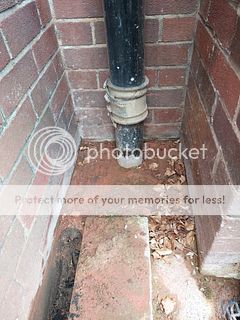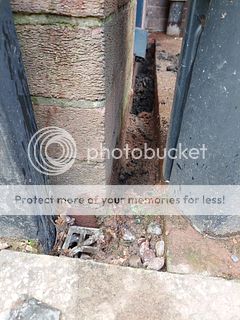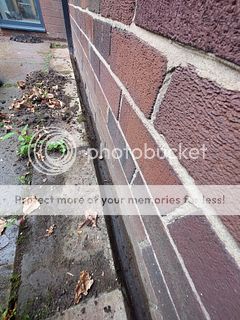Home › Forums › Chat Forum › Patio-soil stack-wall interface and damp
- This topic has 11 replies, 8 voices, and was last updated 2 years ago by kormoran.
-
Patio-soil stack-wall interface and damp
-
wooobobFull MemberPosted 2 years ago
We’ve found some damp just above skirting level on an internal wall. In the meantime, I’ve had on the ‘to-do’ list the task of clearing and checking over the back wall where the patio (which looks like it’s just been slung down on top of the old one) and soil stack ‘base’ (i.e. where the pipe has been surrounded with cement) are both at/above (or at least close to) the DPM. There’s a messy channel around the wall, full of stones and soil, although one area looks like it does have a narrow drainage channel.
The internal wall behind the stack is damp. I’m assuming (subject to further examination for any internal leaks, although there are very few obvious candidates) that the damp is coming from where the rain falls at the base of the soil pipe and sits there in a damp corner, gradually permeating the wall, and has eventually travelled along the base of the wall for c.3m, leaving damp patches on the plaster.
The whole thing is approx. 25-30 years old, when the back extension was built (previous owner). There aren’t any obvious roof/gutter vulnerabilities. The plaster feels damp but looks sound, and the wallpaper wasn’t too bad although it peeled off more easily in those areas. For those who know (and given that I’m ruling out ‘rising damp’ primarily thanks to reassurance from on here!):
1. I assume the ideal solution would be to pull up the patio, dig out the cement at the base of the soil pipe, find the (I can’t actually see it currently) DPM and re-do it all, putting in place proper drainage and space between the patio and the wall?
2. If that’s too difficult/expensive, and given it’s not a major issue as far as I can see, will clearing out the 10cm gap between the patio and wall, filling with pebbles, and then effecting some form of barrier/shelter around the soil pipe probably suffice?
3. Is there anything else I’m obviously overlooking?
I’ll try to post photos 🙂



 jim25Full MemberPosted 2 years ago
jim25Full MemberPosted 2 years agoNew patio slapped on top of the old is most likely too high.
Patio should be 150mm below your damp proof course, that’s 2 courses of brickwork.singletrackmindFull MemberPosted 2 years agoCant see a damp proof course in the brickwork. So it may be breached or as jim says too near the dpm and its bridging somehow.
You say internal wall, but i think you mean inside an external one?I dug out all rpund my house and used permeable membrane and pea shingle to keep everything dry. Not sure if that’s going to work for you. Might be new patio time, or another solution.
Weird building round the soil stack like that. You may find breaking that out with a big sds will give some more clues, then resurface it lower with drainage.
timbaFree MemberPosted 2 years agoWhat’s inside? Is there a cupboard, appliance or similar?
It could be condensation caused by the outside being permanently cold (in shadow?) and damp, although this is way more likely with a solid wall
Assuming there is a cavity is it insulated?
I can’t see the outside detail on this little screen, let’s hope nothing’s leaking. Be careful digging around the soil pipe, it’ll be a pain to access if you break somethingwooobobFull MemberPosted 2 years agoYeah, I’m wary of starting to dig that out myself, it seems like the kind of job that can escalate quickly!
I think the wall behind the soil pipe is a cavity wall, but I don’t know if it’s insulated, I suspect not. The inside of that wall is a bit damp, along with the bottom of an internal wall which runs perpendicular to it. Dining room on one side, kitchen on the other. Dining room side feels damp, kitchen not. It doesn’t get direct sun so that’s a plausible cause.
The patio/gulley around the wall is sort of incidental, although I do want to tidy it up. There is a DPM, it’s half the height above the patio that it should be. New patio is going to be a big expensive PIA, particularly as we don’t have access other than through the house.
Thanks for your suggestions.
temudginFull MemberPosted 2 years agoHow well is that coupling on the soil stack sealed, could it be leaking above ground?
singletrackmindFull MemberPosted 2 years agoSecond picture down, end of the block wall, is that a drain ovet a soakaway?
Then green mold /algae growing on the blockwork above is indictitive of moisture thats not drying out.
wooobobFull MemberPosted 2 years agoIt is a drain cover. I’ve dug out all around it now, most of the gulley was full of sand, soil and pebbles. Thinking I might line the gulley with membrane or guttering and refill with pebbles – hopefully more water will drain away.
csbFree MemberPosted 2 years agoThat’s what I’d do rather than lower the whole patio, French drain all round.
pk13Full MemberPosted 2 years agoGuy next door did the dig it out method and left out the pebbles as an experiment old 1930 house dry as bone now. Went down 3 bricks then build a little gully wall into a soak away half way into the lawn you can actually see the green difference.
He is not a believer of rising damp.kormoranFree MemberPosted 2 years agoYes I have done similar – I filled the trench with a pebble sausage, basically I lined the trench with a permeable membrane then filled it roughly 3/4 full with pebbles. Folded over the membrane to close the sausage then put loose pebbles on top to fill level. The membrane stops all the fines and stuff washing in and eventually filling the spaces in the pebbles.
On a wider trench i put in a 60mm perforated pipe for good measure and then ran the end out into the lawn. All good now.
Also check the levels on the patio to make sure they are draining away from the house
You must be logged in to reply to this topic.
